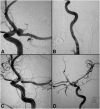Utilization of the Ballast Long Guiding Sheath for Neuroendovascular Procedures: Institutional Experience in 68 Cases
- PMID: 34025546
- PMCID: PMC8137819
- DOI: 10.3389/fneur.2021.578446
Utilization of the Ballast Long Guiding Sheath for Neuroendovascular Procedures: Institutional Experience in 68 Cases
Abstract
Background: The rise of neurointerventional devices has created a demand for guide systems capable of navigating to the carotid artery consistently regardless of tortuosity. The shift toward large distal access catheters (DACs) and desire for greater trackability have inspired the creation of flexible, supportive, large-lumen long guiding sheaths. Recently, the Ballast long guiding sheath was introduced to provide stability and flexibility while navigating neurointerventional devices through tortuous intracranial anatomy. Objective: To report our experience using the Ballast long guiding sheath in a series of patients undergoing a variety of neuroendovascular procedures. Methods: We retrospectively identified all patients who underwent neuroendovascular treatment with a long guiding sheath were selected from a prospectively maintained endovascular database from January 2019 to November 2019. Baseline clinical characteristics and procedural details were collected. Results: A total of 68 patients were included, mean patient age 67.6 ± 13.6 years. Of the patients treated, 52.9% (36/68) presented with stenosis, 25% (17/68) with aneurysms, 13.2% (9/68) with stroke or emboli, 1.5% (1/68) with a tumor, 1.5% (1/68) with an arteriovenous fistula (AVF), and 4.4% (3/68) with a carotid web. Of the patients with stenosis, 20/36 (55.6%) were extracranial, and 16/36 (44.4%) were intracranial. The Ballast long guiding sheath was used to deliver treatment devices for stenting (37/68, 54.4%), flow diversion (12/68, 17.6%), mechanical thrombectomy (8/68, 11.8%), endovascular coiling (5/68, 7.4%), liquid embolization (3/68, 4.4%), balloon angioplasty (2/68, 2.9%), and balloon angioplasty with stenting (1/68, 1.5%). No Ballast-related complications or adverse events were encountered. Conclusions: We demonstrate the feasibility of the Ballast long guiding sheath to successfully deliver modern neurointerventional treatment devices through tortuous anatomy.
Keywords: aneurysm; endovascular therapy; long guiding sheath; stent; stroke.
Copyright © 2021 Hassan, Burke, Monayao and Tekle.
Conflict of interest statement
AH serves as a consultant and speaker for GE Healthcare, Medtronic, Stryker, Microvention, Penumbra, Balt USA, and Genentech. EB contracts with Superior Medical Experts. The remaining authors declare that the research was conducted in the absence of any commercial or financial relationships that could be construed as a potential conflict of interest.
Figures





Similar articles
-
Fubuki XF Long Sheath guide catheter use in neuroendovascular procedures: Institutional experience in 60 cases.Interv Neuroradiol. 2024 Apr 9:15910199241245601. doi: 10.1177/15910199241245601. Online ahead of print. Interv Neuroradiol. 2024. PMID: 38592015 Free PMC article.
-
Early experience with a novel 088 long sheath in transradial neurointerventions.Clin Neurol Neurosurg. 2021 Mar;202:106510. doi: 10.1016/j.clineuro.2021.106510. Epub 2021 Jan 20. Clin Neurol Neurosurg. 2021. PMID: 33529966
-
Balloon-assisted guide catheter positioning to overcome extreme cervical carotid tortuosity: technique and case experience.J Neurointerv Surg. 2014 Mar;6(2):129-33. doi: 10.1136/neurintsurg-2013-010655. Epub 2013 Mar 7. J Neurointerv Surg. 2014. PMID: 23471076 Free PMC article. Review.
-
Feasibility and Safety of Radial-First Approach with a Radial-Specific Neurointerventional Guiding Sheath for Intracranial Aneurysm Coiling in the Anterior Circulation.World Neurosurg. 2020 Oct;142:e297-e306. doi: 10.1016/j.wneu.2020.06.205. Epub 2020 Jul 1. World Neurosurg. 2020. PMID: 32622061
-
Endovascular management of internal carotid artery injuries secondary to endonasal surgery: case series and review of the literature.J Neurosurg. 2016 Nov;125(5):1256-1276. doi: 10.3171/2015.6.JNS142483. Epub 2016 Jan 15. J Neurosurg. 2016. PMID: 26771847 Review.
Cited by
-
Radial access with the Piraeus 7Fr 87 NeuGlide catheter: A single center study of 40 patients.Interv Neuroradiol. 2025 Jun 10:15910199251345037. doi: 10.1177/15910199251345037. Online ahead of print. Interv Neuroradiol. 2025. PMID: 40491273 Free PMC article.
-
First multicenter study evaluating the utility of the BENCHMARKTM BMXTM 81 large-bore access catheter in neurovascular interventions.Interv Neuroradiol. 2024 Jun 20:15910199241262848. doi: 10.1177/15910199241262848. Online ahead of print. Interv Neuroradiol. 2024. PMID: 38899910 Free PMC article.
-
Fubuki XF Long Sheath guide catheter use in neuroendovascular procedures: Institutional experience in 60 cases.Interv Neuroradiol. 2024 Apr 9:15910199241245601. doi: 10.1177/15910199241245601. Online ahead of print. Interv Neuroradiol. 2024. PMID: 38592015 Free PMC article.
-
Use of a large-bore 088 intracranial access support catheter for delivery of large intracranial devices: case series with the TracStar LDP in 125 cases.J Neurointerv Surg. 2024 Nov 22;16(12):1228-1231. doi: 10.1136/jnis-2023-021054. J Neurointerv Surg. 2024. PMID: 38418227 Free PMC article.
-
Initial experience of using a large-bore (0.096″ inner diameter) access catheter in neurovascular interventions.Interv Neuroradiol. 2024 Jun;30(3):372-379. doi: 10.1177/15910199221127074. Epub 2022 Sep 16. Interv Neuroradiol. 2024. PMID: 36114634 Free PMC article.
References
LinkOut - more resources
Full Text Sources
Other Literature Sources

